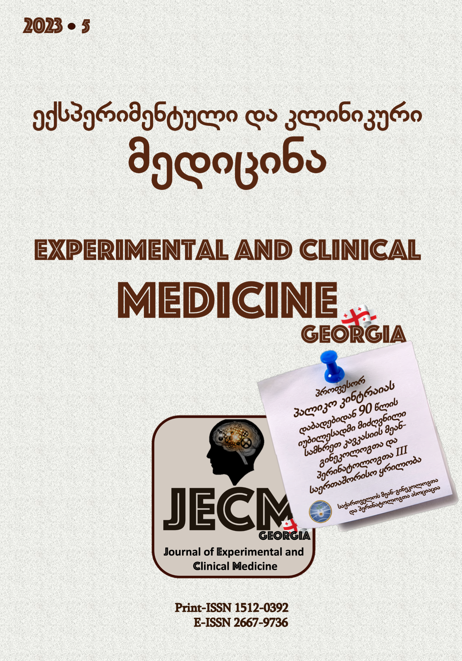საშვილოსნოს ყელის ინტრაეპითელური ნეოპლაზიის და ქრონიკული უროგენიტალური კანდიდოზის მქონე პაციენტების კომბინირებული მკურნალობა
DOI:
https://doi.org/10.52340/jecm.2023.05.02საკვანძო სიტყვები:
cervix, papillomavirus, genital candidiasis, antiviral therapy, immunomodulatory therapy.ანოტაცია
საშვილოსნოს ყელის HPV ინფექციით და გენიტალური კანდიდოზით HPV-ის კომბინირებული ფორმების მკურნალობის კომპლექსური მიდგომა, რაც მოიცავს კომბინირებულ თერაპიას პაპილომატოზური წარმონაქმნების დაზიანების დესტრუქციული მკურნალობისა და ანტივირუსული და იმუნომოდულატორული მოქმედების მქონე წამლების გამოყენებით, შეიძლება ჩაითვალოს ყველაზე ეფექტურად მიმდინარე ეტაპზე. ამ პრეპარატების გამოყენება ამცირებს HPV-ის მდგრადობას და დაავადების რეციდივების გაჩენის ალბათობას.
Downloads
წყაროები
Прилепская В.Н., Новикова Е.П. Возможности раннего лечения и профилактики папилломавирусной инфекции. Гинекология. 2013, том 15, № 1, с.94-97.
Прилепская В.Н., Довлетханова Э.Р. Особенности диагностики, клинической картины и лечения заболеваний, ассоциированных с папилломавирусной инфекцией. Гинекология. Том 15, №5, с.7-12.
Роговская С.И., Бебнева Т.Н. Цервикальная папилломавирусная инфекция. Возможности комбинированной терапии. Акушерство и гинекология. 2016, №10, с.26-32.
Роговская С.И., Липова Е.В. Шейка матки, влагалище, вульва. Руководство для практикующих врачей. М., 2014, 832 с.
Савичева А.М., Башмакова М.А., Краснопольских Т.В. Лабораторная диагностика бактериального вагиноза: Методические рекомендации. ¬СПб: издательство Н-Л, 2014. 28с.
Сухих Г.Т., Прилепская Т.Н. и др. Руководство для врачей. 2012. 192 с.
Хрянин А.А., Тапильская Н.И., Кнорринг Г.Ю. Современные представления о папилломавирусной инфекции: эпидемиология и тактика ведения пациентов с аногенитальными бородавками. Клиническая дерматология и венерология 2020; том 19, №5
Gillet E., Meys J. F., Verstraelen H., et al. Association between bacterial vaginosis and cervical intraepithelial neoplasia: systematic review and meta-analysis. PLoS One. 2012;7(10) doi: 10.1371/journal.pone.0045201.e45201
Huh W. K., Ault K. A., Chelmow D., et al. Use of primary high-risk human papillomavirus testing for cervical cancer screening: interim clinical guidance. Gynecologic Oncology. 2015;136(2):178-182. doi: 10.1016/j.ygyno.2014.12.022.
Kjaer S. K., Frederiksen K., Munk C., Iftner T. Long-term absolute risk of cervical intraepithelial neoplasia grade 3 or worse following human papillomavirus infection: role of persistence. JNCI Journal of the National Cancer Institute. 2010;102(19):1478-1488. doi: 10.1093/jnci/djq356.
Mitra A., MacIntyre D. A., Marchesi J. R., Lee Y. S., Bennett P. R., Kyrgiou M. The vaginal microbiota, human papillomavirus infection and cervical intraepithelial neoplasia: what do we know and where are we going next? Microbiome. 2016;4(1):58. doi:10.1186/s40168-016-0203-0.
Small W., Jr., Bacon M. A., Bajaj A., et al. Cervical cancer: a global health crisis. Cancer. 2017;123(13):2404-2412. doi: 10.1002/cncr.30667
So K. A., Lee I. H., Kim T. J., Lee K. H. Risk factors of persistent HPV infection after treatment for high-grade squamous intraepithelial lesion. Archives of Gynecology and Obstetrics. 2019;299(1):223–227. doi: 10.1007/s00404-018-4936-9.






